Egypt and the Semites Part III: The New Kingdom; From Progress to Predation
Fact Paper 10-III
© Samuel Kurinsky, all rights reserved
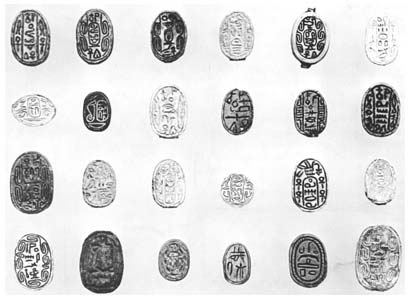
- Hippopotami and Egyptian History
- Monotheism, Autonomy, and the Aamus
- Sequernene's Son Picks up the Cudgel
- Ahmose Carries on the Family Vendetta against the Hated Semites
- From Progress to Predation
- Additional Material Submitted by Visitors
- Notes
Hippopotami and Egyptian History
Libidinous hippopotami changed the course of Egyptian history!
The sexual antics of hippopotami sparked the events that ended the most progressive period of Egyptian history and led to the predatory rule of the "Warrior Pharaohs" of the New Kingdom, Egypt's 18th dynasty. The events took place during the reign of King Apophis, the sixth and last "Hyksos" king of Egypt.

Fact Paper 10-II related how Egypt experienced its greatest cultural leap forward of its long history during the two centuries in which Egypt was ruled by the Hyk Khase (commonly rendered as "Hyksos"). They were patriar-chal chieftains of Semitic peoples originating from Canaan.1 Designated "The Second Intermediate Period," little appreciation has been forthcoming for the unprece-dented progress made in every aspect of Egyptian life during those two centuries, when Egypt was propelled from the Copper-Stone into the Middle Bronze Age. 1t was the most egalitarian period of Egyptian history, in which the chieftains of the Asiatic villages of Lower Egypt appointed one among them to act as chief-of-all-chiefs. He was accepted by the Egyptians as a king of all Egypt and Canaan. The Egyptian overlords of Upper Egypt were treated equitably under the reign of the Hyk Khase. They prospered, and as Egyptian inscriptions attest, were content to remain under the rule of the Semites, or Aamus, as the Asiatics were termed in Egyptian.
King Apophis thus reigned over all Canaan and Egypt, whose population also included many of the lumbering beasts, the hippopotami.
Some of the Asiatic chieftains established winter residences in Upper Egypt, where they could bask in the balmier equatorial climate. A number of winter retreats were located in the vicinity of the fief of Sequernene, a Theban grandee. Among them was the winter retreat of the chief-of-all-chiefs, the Semitic King Apophis.
Sequernene's estate fronted on the Nile. It en-compassed a pool where hippopotami loved to make love. Hippopotami engaged boisterously in foreplay, bellowing loudly and cavorting noisily about in the late evening, much to the annoyance of Sequernene's Aamu neighbors.
The Aamus continuously complained to Sequer-nene of sleeplessness occasioned by the raucous and rambunctious hippopotami. They were ignored, or given cursory, insulting responses, for Sequernene felt that hippopotami, being more Egyptian than his Semitic neighbors, had every right to freely express themselves, however stridently. Sequernene considered it presumptuous of the Aamus to believe that an Egyptian prince (Sequernene fancied himself of royal blood) would interfere in the sex life of native Egyptians for the edification of Asian aliens.
Finally, King Apophis himself sent a messenger with a note to Sequernene, complaining that his hippopotami were inconveniencing his neighbors. Sequernene inscribed his outrage at the Semite's arrogance on stone:
Now when the messenger whom Apophis had sent reached the Prince of the Southern City [Sequernene of Thebes], he was taken to the Prince of the Southern City....."What brings thee to the Southern City? [asked Sequernene]. "It is King Apophis who sends to thee saying [the messenger] has come concerning the pool of the hippopotami, which is in thy city. For they permit me no sleep, day and night the noise of them are in my ear. " Then the prince of the Southern City lamented for a [long] time.2
Sequernene was not of royal blood, but merely the second generation of a lineage that stemmed from humble roots. He was intensely jealous of the Asiatic chieftains, whom he considered to be interlopers. He abominated Apophis, the chief-of-all-chiefs chosen by the other Aamu chieftains to rule Egypt and Canaan.
Monotheism, Autonomy, and the Aamus
Sequernene envisioned himself as potentially a divinely endowed pharaoh on the throne of Egypt. Using the Hippopotami affair as an excuse, he attempted a coup. The affair was merely a pretext for his ambitious initiative, for Sequernene's antipathy toward the Aamus had deeper roots. Sequernene found two facets of Hyk-Khase rule particularly insufferable:
The Aamu substitution of a single, universal god for the panoply of Egyptian gods.
A government embracing the principle of rule by consensus.
These odious attributes of rule by the Hyk-Khase were chronicled in the very inscriptions that Sequernene had incised in stone to explain and justify his actions. The rule over Egypt under such un-Egyptian precepts by the Hyk Khase are abundantly supported by other Egyptian records as well as by archaeological evidence. As late as the Ptolemaic period, Manetho, an Egyptian priest who subscribed to the Egyptian precept of royal divinity and whose writings Egyptologists employ as the basis for Egyptian history, disdainfully related that the Hyk Khase, after conquering Egypt
...appointed as king one of their number whose name was Salitis. He had his seat at Memphis, levying tribute from Upper and Lower Egypt.3.
The Aamus established a decentralized system of government eventually administrated from its seat of government in the capital city of Avaris. Allegiance to Aamu rule was compliantly adhered to by local authorities, both Semitic and Egyptian. Sequernene found the sheepish acquiescence by Egyptian overlords to the kingly rule by a Hyk-khase inherently offensive. Sequernene found particularly abhorrent the fact that the Aamu kings neither did nor could claim divinity, and did not even pretend to have divine sanction for their powerful position.
In 1976 the Austrian Institute of Technology in Cairo was digging at a site known as Tel el-Daba, just south of Qantit. Dr. Manfred Bietak, director of the institute and of the campaign, found several strata that disclosed continuous occupation of the site during the Second Intermediate Period by a purely Asiatic and basically Semitic population.4 There lay the remnants of the biblical city of Avaris, located in the very area designated for it in the Bible. Featured among the ruins were two temples dedicated to Sutekh, and the references to him confirmed the monotheism of the inhabitants. Sutekh was depicted wearing clothes and a headdress which bore a district resemblance to that of the Semitic Baal.5 In exodus 1:12 we read how the Israelites built two great store cities in Egypt, Pithom and Avaris. Papyri recovered from ancient tombs contemporary with the times extol the greatness of Avaris, affirming the accuracy of the biblical references to the city. P. H. Newby relates that:
Writers of the time were ecstatic in its praises. Its great buildings were embellished with glazed tiles the color of turquoise and lapis-lazuli; the river, the lakes, and the canals teemed with fish; vineyards produced wine of kankeme "sweeter than honey"; its granaries were full of wheat; all fruits and vegetables grew there in abundance... pomegranates apples, olives, figs - and whatever the city lacked could be brought in by sea-going ships right into the busy harbor.6
The papyri on which these praises were written describe a great temple dedicated to the single god revered by the Semites, who was there worshiped under the Egyptian name :Sutekh." They record how the Hyk Khase, the Aamu chief-of-all-chiefs, delighted to walk in the extensive gardens in the back of the temple. The Austrians found the second Sutekh temple in the southern quarter of the partly uncovered city, exactly where the papyri had placed it. It had pale blue walls, the favorite color of the Semites. It sat conveniently on a gezira, a dry mound surrounded by the lush, periodically inundated countryside. The gezira bordered the south side of a lake at the head of a semi-circular harbor. The lake was connected by a canal to a bend of the Pelusaic branch of the Nile. Upstream lay Memphis and Thebes, downstream lay the Mediterranean. A canal led eastward through another lake to the penitentiary city of Tjel, from which a military road led through the Sinai, following the Canaanite coast as far as Ugarit. There it connected to a transverse road leading to Anatolia, Assyria, Babylonia, Afghanistan and India.
The lack of appreciation by historians, Egyptologists, and museums of the transformation of Egyptian civilization under the inspired dynamism of Aamu rule is all the more baffling when the implications of the importance of the ancient city of Avaris is taken into account. In addition to being a government center, it hosted a variety of important commercial establishments and was a bustling hub of Near-Eastern trade. Not least are the implications of its role as a center of revolutionary new religious precepts.
Avaris was destroyed by the Pharaohs of the Eighteenth Dynasty. Ramesis II and Seti I of the nineteenth dynasty built a new city on the ruins of Avaris. They took full advantage of the web of drainage canals left by the defeated Semites, canals that generated the most productive region of Egypt and continue to do so unto this day. Credit to the Aamus for having created the dynamic system is minimally and grudgingly forthcoming from the scientific community.
It cannot be expected that Mosaic monotheism had been fully articulated at this early period. It is, however, of momentous historical import that the concept of a single and universal god had already become integral to an essentially Semitic culture hundreds of years before its presumed advent at Mount Sinai. Is it not, to say the least, curious that these circumstances have hardly been noted? Is it not astonishing that little exegetical relevance has been attributed to the clearly defined basis for the Mosaic precepts laid down by the Aamus at Avaris?
Sequernene (as did other Egyptian overlords)expressed his abhorrence to such un-Egyptian heresy:
Now it befalls that the land of Egypt was in dire affliction and there was no sovereign as king at the time. And it happened that king Sekernene was ruler of the southern City...7 while the chieftain Apophis was in Avaris and the entire land paid tribute to him in full, as well as with good things of Timirus.8 Then king Apophis took Sutekh, and served not any God which was in the entire land except Sutekh. And he built a temple of fair and everlasting work by the side of the house of King Apophis, and he rose every day to make sacrifice to Sutekh."9
It is interesting to note that Sequernene first refers to Apophis as merely a "chieftain," although he states that Apophis was the ruler to whom "the entire land paid tribute." Nonetheless, he thereafter twice refers to Apophis as "king at the time!" Sequernene's complaint that "there was no king at the time" is an illuminating affirmation of the autonomous nature of the political structure, and his dichotomous allusions to the status of Apophis, on top of this complaint, testifies to the means by which Apophis was chosen ruler to whom, again, "the entire land paid tribute." This inscription is one of many testimonies to a government powered by the consent of the governed and to the peaceful coexistence between the hundreds of patriarchal village chieftains and between them and their Egyptian neighbors.
The inscriptions clearly designate the Aamus as monotheistic. Other inscriptions by subsequent Egyptian rulers likewise testify to the monotheism practiced by these "Asiatics." For Example, John A. Wilson quotes the oft-told "folk tale written down in the nineteenth dynasty:... for King Apophis was in Avaris, and the entire land was subject to him with their dues... and king Apophis made him Seth [Sutekh] a Lord, and he would not serve any god who is in the land except Seth.".10
The Aamu's association with Sutekh reflects an identification of the God with Ba'al, El, or Yahweh. The Aamus were sometimes sneeringly called Setyu by Egyptians under the assumption that they were followers of the Egyptian god, transcribed as Set or Seth.
It is possibly significant that, according to Egyptian tradition, Seth slaughtered Osiris, the central figure of the panoply of Egyptian gods. Whereas the Egyptians held that Osiris rose from the dead, and by inference held out he hope for eternal life, the Aamus simply proclaimed Sutekh as creator and ruler of the universe. Gardiner adds: "Their version of Seth, now written in Babylonian fashion as though pronounced as Sutekh, was certainly more Asiatic in character than the native original, bearing in his garment and head-dress a distinct resemblance to the Semitic Ba'al."11
It is certainly of significance that, albeit some gestures were made to the Egyptian practice of lending legitimacy to rule by reference to Re or to another Egyptian deities, generally the Semitic kings did not include Sutekh in their personal cartouches12. This circumstance, running counter to Egyptian practice, suggests that the omission represents a deliberate denial of divine rights for rulers.
Again, one is compelled to ask: "Why has this eloquent and significant record been ignored?
Sacrifices to Sutekh were performed daily at a magnificent temple next to the king's dwelling at Avaris, and garlands of flowers were maintained permanently at the shrine. That a few of the Aamu chieftains appear to have bowed to Egyptian customs in limited ways, can be understood as a variance in the levels of belief in Sutekh, or, more probably, to conciliate the Egyptians by employing symbolic Egyptian religious trappings.
Ambition makes brutes of men. Pseudo-princes are men, and more ambitious than most. Sequernene's attempt to overthrow Apophis ended in ignominious defeat.
Sequernene's mummy bears the mute evidence of his failure. He suffered a number of debilitating blows, evidently from a war-club, and was finally dispatched by a massive penetration of his skull by a battle-axe. The contours of the wound match precisely those of the distinctive battle-axes wielded by the Asiatics. Sequernene's mummy rests on display in the Cairo museum, broken jaw, huge hole in his head and all.
Sequernene's Son Picks up the Cudgel
Sequernene's oldest son, Kamose, continued the record of this history by having it inscribed on stone steles. Some have survived. They recall the events that had occurred and record the events that followed. The inscription of an early stele details the proceedings of a council meeting convened at the behest of Kamose and attended by the Egyptian hierarchy of Upper Egypt. Kamose proposed that to avenge his father's death, and to restore Egyptian pride and glory, a joint effort be launched to unseat the Semitic Hyk Khase and return rule to Egyptians.
Kamose himself states that his proposal was summarily rejected by one and all of the Egyptian nomarchs. Kamose bitterly lamented that the attendant Egyptian overlords argued the inadvisability of executing his proposal because Egyptians favored the rule of the Asiatics and therefore would not fight. The nomarchs contended that the treatment they received at the hands of the Aamus was outstandingly congenial. The southerners were welcome to seasonally pasture their cattle in the grassy north. They pointed out that in addition, when drought in the south created the need, they were generously granted grain to sustain their swine. "All are loyal as far as Cusae," Kamose quoted them as stating in support of their refusal to join Kamose in furthering his ambitions.
Kamose included these arguments in his inscription to denigrate the Egyptian overlords. The tone of his remarks indicates his contempt for these soft-hearted fellow princes, and his indignation for how easily they were swayed from glory by the benign treatment afforded them by the Asiatics!
We must thank Kamose for setting the record straight, understanding that he did so boastfully to prove to posterity that he was able to overcome all odds by inscriptively thumbing his nose at the weaklings who stood against him. He wrote as if he were already a divinely invested king, an assumption belied by his third-generation tenure as a lord and by the limits of the local lands to which he could lay claim. The text of the inscription is given by Gardiner as follows:
In the year 3 of the mighty king in Thebes Kamose, whom Re had appointed as the real king and granted him power in very sooth. His majesty spoke in his palace to the council of grandees who were in his suite: "I should like to know what serves this strength of mine, when a chieftain in Avaris, and another in Cush, and I sit united with an Asiatic and a Nubian, each in possession of his slice of Egypt, and I cannot pass by him as far as Memphis. See he holds Khmun, and no man has respite from his spoliation through servitude to the Setyu. I will grapple with him and slit open his belly. My desire is to deliver Egypt and smite the Asiatics." Then spoke the grandees of his council, "See all are loyal as far as Cusae. We are tranquil in our part of Egypt. Elephantine is strong, and the middle part is with us as far as Cusae. Men till for us the finest of their lands. Our cattle pasture in the Papyrus marshes. Corn is sent for our swine. Our cattle are not taken away."13
Kamose, no less ambitious than was his father, viewed himself grandly as "the mighty king in Thebes," thus recorded his contempt for the advice of his fellow grandees and his outrage for their desire to maintain peaceful relations with a government of foreigners. Frustrated by the lack of Egyptian support, and unreconciled by the caution of the more circumspect courtiers, Kamose organized an army of mercenary troops. They consisted mainly of Medjas, a primitive and outlaw Nubian tribe. Kamose did not act impetuously as did his father, but carefully prepared for an invasion of Lower Egypt over a period of a few years. He then launched new attacks, sailing down the Nile on a flotilla of boats and rafts.
I fared downstream in might to overthrow the Asiatics by command of Amn, the just of counsels, my brave army in front of me like a breath of fire, troops of the Medja-Nubians aloft upon our cabins to spy out the Setyu and to destroy their places."14
The invaders succeeded in penetrating deep into the Delta, destroying everything in their path. Kamose relates in a second stele how he captured one enemy fortress and chased the enemy's "horses" into a second fortress deep in Hyk Khase territory. " Here, presumably at the end of the Hyksos occupation, we find our first reference to in an Egyptian text to the horse, ana animal which may not have been used by the Asiatics in their conquest of Egypt, but which was destined in the centuries to come to play a leading role in the establishment of Egypt's Asiatic empire."14A
Kamose goes on to relate how he captured a fleet of Hyk Khase ships, with "all good products of Retenu (Canaan)."
In this campaign Kamose found strong resistance among Egyptians. Kamose's outrage at loyal Egyptians grew to new heights when he found that the Egyptian communities in Lower Egypt were even more supportive of the Aamu administration than were the Upper Egyptian barons, and were as resistant to the incursion as were the Semites! He wreaked revenge upon these "traitors," subjecting them to even harsher punishments than that inflicted upon the defending Aamus.
Flushed with initial success, anticipating ultimate victory, he exultantly ordered his passion to be inscribed on stone. Thus Kamose recorded for posterity the merciless vengeance he wreaked upon his own people, Egyptians who acted upon their desire to live in peace with the Asiatics. Kamose was particularly irate with a prominent Egyptian who had shut himself up just north of Khmun, which Kamose stated had been
...made into a nest of Asiatics... I slew his people and I caused his wife to go down to the river-bank. My soldiers were like lions with their prey, with serfs, cattle, milk, fat, and honey, dividing up their possessions.15
Kamose continued his campaigns, but was finally driven back in humiliating defeat. He wreaked further wrathful retribution upon Egyptian loyalists in the path of his retreat, ravaging them even more ruthlessly than he did the Asiatic communities.16
I razed their towns and burned down their places, they being made into ruins forever on account of the damage which they did [sic!] within this Egypt, and they had made themselves serve the Asiatics and forsaken Egypt their mistress.17
It becomes ever more clear from Kamose's continuing account of his adventures that ordinary Egyptians, far from being treated unkindly by the Aamus, were enjoying the fruits of an ongoing, beneficial relationship, were appreciative of the technological and cultural advances the Semites had introduced, and had no desire to return to the autarchic tyranny whose memory they still retained They regarded the ambitious Theban as an interloper who not only did not represent their interests but was acting contrary to them. This fact and the frustration Kamose felt in his failed attempt to appeal to them on nationalistic grounds led to his bitterly rendered account of revenge: Kamose continued to unabashedly chronicle his bloody misadventures, Gardiner stresses, "That the Theban was by no means ashamed of his ruthlessness toward his own countrymen is clear from his own words."
Ahmose Carries on the Family Vendetta against the Hated Semites
Aamu government did not end with Kamose's demise. It was dismantled and destroyed ten years later by a subsequent adventurer, his brother Ahmose. Avaris fell to Ahmose in the third of his campaigns, a history vividly recorded in an autobiography of a ship's captain who was one of the main participants in the siege. As soon as Ahmose became the first pharaoh of the Eighteenth Dynasty (c. 1570 B.C.E.), he embarked upon a campaign of obliteration of every trace of the presence of the Semites. Ahmose over-ran the Delta, ravaging the countryside even more ruthlessly than Kamose had done before him. His armies looted and destroyed the cities built by the Asiatics, tearing down every standing structure and obliterating every inscription that might remind posterity of the hated aliens. The Aamus that were not killed or enslaved were driven back into Asia across the eastern desert. He pursued them into Canaan, destroying the cities of Tell el-Ajjul, Beth Shimesh, Shiloh, and Beth-Zur. The process of obliteration was continued by the successors to Ahmose. The pharaoh Thut-mose I campaigned up to the banks of the Euphrates where he triumphantly set up a stele. Subsequent Egyptian monarchs continued the obliteration of the record of Hyk Khase rule and of their despised practice of monotheism. Wilson cites an inscription by Queen Hat-sheput:
I have raised up (again) that which has formerly gone to pieces, since the Asiatics were in the midst of Avaris of the Delta... they ruled without Re, and... did not act by divine command... I have made distant those who the gods abominate and earth has carried off their (footprints)17A
Few physical footprints of the extraordinary Second Intermediate Period have, indeed, survived. '...of the temples built by Hyksos kings there remain only a few blocks of inscriptions from Bubastis, a small obelisk of King 'A-se-R' from Tanis, and a fine granite altar dedicated to 'his father, Sth, Lord of Avaris.' Though what has come down to us is quantitatively unimpressive, the quality of the work is on the whole as good or better than that produced under the independent kings of the thirteenth dynasty."17B
From Progress to Predation
The Eighteenth dynasty kings did not, of course, erase the knowledge Egypt had gained from the Aamus. Nor did they forego the technological advances introduced during the rule of the Asiatics. In fact, the conquest of Canaan was made possible with the horses and chariots the Aamus had introduced into Egypt, and by the improved weapons the Aamus had taught Egyptians to make and to wield.
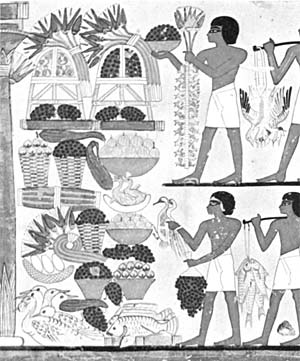
Canaan was overcome because its inhabitants were unprepared for war, inasmuch as their representatives had ruled peacefully over Egypt and Canaan for several centuries. It is a remarkable fact of history that no wars of any consequence occurred during the tenure of the Hyk Khase, the so-called "Second Intermediate Period." No despoliations of neighboring peoples took place during the long reigns of the six Canaanite kings of Egypt.
In contrast, a bloody period of plunder ensued under the Warrior Pharaohs of the "New Kingdom." It commenced with incursions into Nubia and ended with the conquest of Canaan.
An era of progress ended. An era of predation began. Once more a host of slaves taken in war were put to building massive monuments for the glorification of their masters. Once more workers and farmers were taxed and indentured to build great palaces for rulers who had no regard for popular consensus. Once more the resources of the land were committed to furnishing and decorating the dwellings and tombs of autocrats who wielded the whips of unmitigated power.
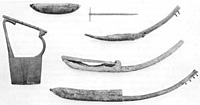
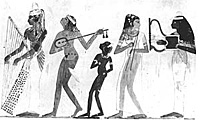
Once more, under unremitting repression, creativity was stifled and progress came virtually to a halt. The land of Egypt no longer waxed wealthier from increasing productivity. While the people of Egypt scrounged for sustenance, the Egyptian hierarchy grew rich and fat from the spoils of war, and from squeezing every possible drop of equity from its populace.
The hierarchy of Egypt was enabled to muster great wealth for themselves by virtue of the innovations the Semites had made to Egypt's economy. Early on in the Second Intermediate Period the Bahr Yousef, or "Joseph's canal," was thrust through the sands of the western desert. A web of canals leading from the Nile's twin into the wastelands of Egypt made the desert bloom. The erstwhile desert was watered to yield Asian fruits and vegetables which the Aamu had introduced, a vast assortment of produce the Egyptians had never seen before.
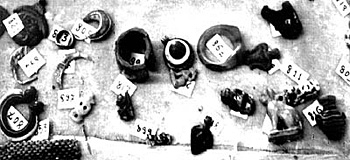
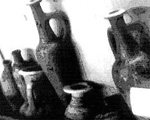
New fruit trees, had been planted by the Aamu, pomegranates and figs and olives. A variety of Asian grains and vegetables flourished in the irrigated sands Egypt, and even the cornflower, a common Canaanite flower became a favorite of the pharaohs. Painters were enjoined to use the cornflower lavishly in the tombs of the overlords, so that they could be eternally surrounded by beauty.
The succeeding, so-called Eighteenth Dynasty, reached the stature accredited to it solely because the antecedent Semitic rulers had transformed Egypt, vaulting its technology, its economy, and its military potential to great heights. The economic and military prowess Egyptian warlords thus inherited from the Semites enabled them to wrench wealth from neighboring peoples, and to wrest taxes from their own, now more productive populace. The benevolent reformations of Egyptian society by the Semitic peoples of Canaan and Lower Egypt, the Aamus, were redeemed with pain and persecution. The very armor, weapons, and economic power they had brought to Egypt were now used against them. The horses and chariots to expedite the logistics and execution of war, all introduced into Egypt during the Second Intermediate Period, now served the grandees to subjugate their own and neighboring peoples. The Egyptian princes went on to merciless military campaigns, their appetite for loot whetted anew with each incursion.
The pharaohs proudly tell their tales of atrocities committed. Countless thousands of slaves and indentured workers were put to backbreaking work, erecting monuments on which the pharaohs "glorious" deeds are inscribed. Carved into these wide walls are long lists of spoils stripped from conquered peoples, to be deposited into the treasuries and tombs of Egyptian pharaohs, princes, and priests. In addition, the soldiers and officers of the Pharaoh's armies were enjoined to loot, and to render a portion to their commanders, and to the pharaoh himself.
Flagrantly depicted on these Egyptian postcards from the past are scenes repeated on innumerable pillars and walls of prisoners tied together by their necks, their hands bound behind them, being dragged into slavery. An army captain is shown heaping hundreds of severed hands into a large mound before a grateful pharaoh. A commander is shown piling up penises before an appreciative pharaoh who is paying the commander in gold for each penis in the pile.
Great victories, plunder and tribute are proudly recorded by the succeeding Egyptian kings. A typical passage from the famous stele dedicated by Merenptah to his victories and which includes the first mention of Israel reads:
Tjehnu-land is destroyed. Khatti is at peace. Canaan is plundered with every ill, Ashkelon is taken and Gezer seized. Yenoam is as though it had never been. Israel is desolated and has no seed.18
Rameses III was no less explicit. An account of his exploits is given at the end of a famous papyrus. After listing at length the peoples and towns conquered or destroyed the text supplies us with lists of his gains, such as from the campaigns against the Libyans:
I took of those whom my sword spared many captives, pinioned like birds before my horses, their women and children in tens of thousands, and their cattle in hundreds of thousands. I settled their leaders in strongholds called by my name. I gave them to troop-commanders and chiefs of the tribes, branded and made into slaves stamped with my name, their women and children treated likewise. I brought their cattle to the house of Amun, made for him into everlasting herds.19
Who was it, then, that enjoyed prosperity other than the overlords and army officers? The dismal economic state of the countryside becomes clear in Egyptian texts in the very time of the reign of Rameses III. The dire condition of the populace at large, and of the workers on the monuments to the glory of the king provoked the first general strike in recorded history. The workmen engaged in building the royal tomb went on strike to protest their miserable condition despite the might that could be wielded against them and the consequences that might befall the protesters.. The work stoppage ended only after the intervention of a vizier, who was able to supply only half the monthly rations actually due the workmen.20
Far from being satisfied with the slaves and plunder doled out to them, the greedy overlords of Egypt plotted against Rameses and attempted to overthrow him in a harem plot in which twenty-nine officials and six wives, an overseer of cattle, and others were involved.
Perhaps it was because of jealousy against three of Rameses II's wives that the harem plot was hatched. They bore the Semitic names Menhet, Menwi, and Merti and were the daughters of Canaanite chiefs! These wives later received special treatment in death, for they were buried in a common tomb with a full range of jewelry and other rich accouterments. Two of the elaborate, gold headdresses of these women were preserved and are now the proud possessions of the New York Metropolitan Museum of art. They are heavily inlaid with semiprecious stones and colored glass tesserae. No doubt the unrecovered headdress of the third Semitic wife of Rameses III was likewise adorned in royal raiments.
Conditions in the country went from bad to worse. By the time of Rameses IX, social conditions had become so depressed and poverty was so rampant, that tomb-robbery, always a practice, became an urgent subject for royal concern.21
The Semitic chiefs did not record great battles, or slaughters, or riches gained by plundering, for there was little of either during their tenure. Hence such scenes did not descend to historians from the period of Asiatic rule in Egypt, and that is why, on the walls of museums, otherwise erudite scholars inform an innocent public:
"Art declined during the period of Hyksos domination."
It seems that the pictures of piles of penises and of severed hands leave a deeper impression upon Egyptologists than does the introduction of the pomegranate, or of the wheel, or of the lyre, or of a written language with which trade with ones neighbor is facilitated, or of a web of canals that multiplied the food supply of Egypt.
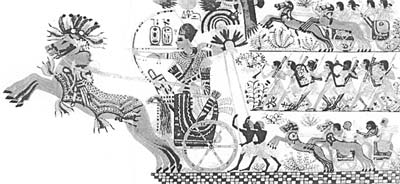
The fact is that in contrast with the massive technological, cultural, and economic gains of the two centuries of Hyk-Khase rule, virtually no progress was made through the next thousand years of Egyptian pharaonic rule.
We may be forgiven for conjecturing that perhaps there was among the wise Semitic viziers at the onset of the Second Intermediate Period one named Joseph We can well imagine that this Yousef, after reorganizing society by separating religion from state, instituted a strong civil government in which villages headed by patriarchal chiefs enjoyed autonomy, who "appointed" one among them to rule over Egypt and Canaan.
We must believe that, indeed, it was such a wise vizier as Joseph who spent many years traversing the desert lands, measuring and calculating in making a comprehensive study of the geodesy of Egypt, and then formulated a plan that transformed the land of Egypt forever.
The canal has long been and is today still called the Bahr Yousef, which translates from the Arabic simply to "The Sea of Joseph."
It is so designated on the maps of Mizraim, the land we call Egypt.
Notes
1: This history is given in Fact Paper 10-II, Egypt and the Semites; The Second Intermediate Period.
2: James Henry Breasted, A History of Egypt, University of Chicago Press, 1960, 186-7.
3: Sir Alan Gardiner, Egypt of the Pharaohs, 1961, reprint Oxford University Press, 1979, 46-7.
4: Manfred Bietak, "Urban Archaeology and the 'Town Problem' in Ancient Egypt," Egyptology, 1979, 97.
5: Sir Alan Gardiner, Ibid., 165.
6: F. B. Newby, Warrior Pharaohs, London, 1980, 166.
7: Thebes.
8: Gardiner, Ibid., 163.
9: A name for Egypt
10: John A. Wilson, The Culture of Ancient Egypt, 1951, reprint 1961, Un. of Chicago Press, 160, quoting A. H. Gardiner in the Journal of Egyptian Archaeology 32, 1946, 43ff.
11: Gardiner Ibid., 164-5.
12: B. G. Trigger et al, Ancient Egypt; A social History, 1983, reprint, Cambridge University Press 1986, 23.
13: Gardiner, Ibid., 166.
14: Gardiner, Ibid, 166.
14A: William C. Hayes, The Scepter of Egypt, The Metropolitan Museum of Art, 1958, 9
15: Gardiner, Ibid., 167.
16: Gardiner, idem.
17: Gardiner, idem.
17A: Wilson, idem.
17B:William C. Hayes, Ibid., 11.
18: Gardiner, Ibid., 273.
19: Gardiner Ibid., 287.
20: Gardiner Ibid., 288.
21: A Rosalie David, The Ancient Egyptians, London, 1982, 140.
22: See HHF Fact Paper 19-III, Jews in Africa, Part III, Egypt, Elephantine Island, and the Jews; Samuel Kurinsky, The Glassmakers; An Odyssey of the Jews, New York, 1991, 62.
23: Hayes, Ibid., 25
